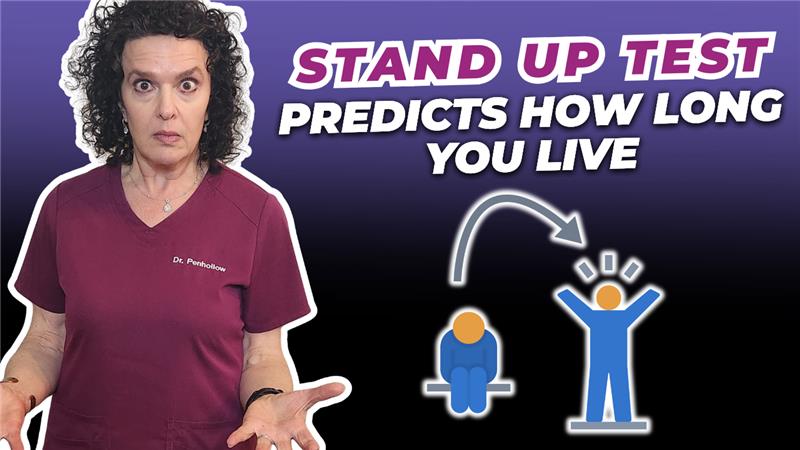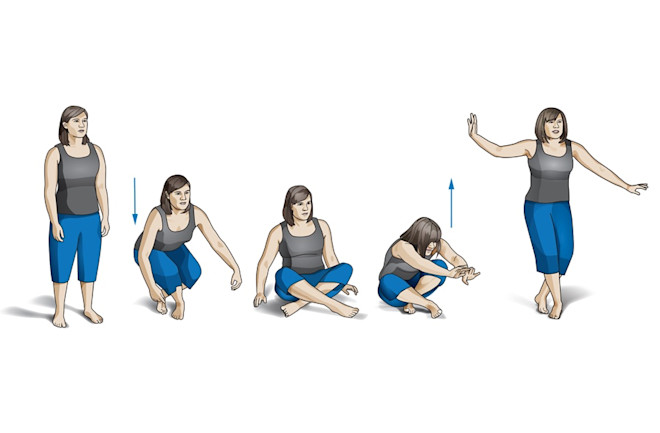
Stand-Sit Test Will Predicts How Long You Live
What if a simple move, such as sitting down on the floor and standing back up, could predict how long you’ll live?
Sounds unbelievable, right? But this quick, science-backed test might hold the key to your longevity, strength, and overall health risk. In this episode, I uncover the shocking research behind the sitting-rising test. I discuss what your score really says about your future, and how to improve it before it’s too late.
Don’t skip this one, your health may literally depend on it. Dive in now and find out what your body’s been trying to tell you all along.
Episode Video
What if one simple move could help predict your health, and even how long you’ll live? That’s exactly what the sitting-rising test does. This simple movement, going from standing to sitting on the floor and back up without using your hands, could reveal a lot about your strength, balance, and overall wellness. And the best part? You can try it at home in just minutes.
Many people are surprised to learn that their sit and rise test score has been linked to a higher or lower risk of dying from all causes, including heart disease. In fact, new research published in the European Journal of Preventive Cardiology shows the lower your score, the higher your risk. But don’t worry, if your number isn’t perfect, there’s a clear path to improving it.

Copyright: Discover Magazine - Simple Sitting Test Predicts How Long You'll Live
What Is the Sitting-Rising Test and How Does It Work?
The sitting-rising test is a 10-point scale that measures how easily you can sit down on the floor and rise back to your feet without using support from your hands, arms, or knees. You start with a perfect 10, five points for sitting down and five for standing back up.
But for every support you use, like putting a hand on the floor, pressing on your knee, or wobbling out of balance, you lose a point or half-point. For example, using one hand to push off knocks off one point. Using a knee for help? That’s another point gone.
The goal is to perform both movements as smoothly and independently as possible. No hands, no knees, no props. A perfect 10 means strong muscles, good balance, and coordination. A lower score could signal weaker strength and a higher health risk.
Sit and Rise Test Score Indications
This isn’t just a fitness test, it’s a potential life-saving clue. Study shows that people with a sit and rise test score between 0 and 4 had more than a 10 times higher risk of death compared to those who scored a perfect 10. Even more alarming, that same group had a 380% greater risk of dying naturally and a 600% higher chance of cardiovascular death.
If you scored in the 6 to 8 range, that’s still a good sign, especially if physical conditions like a joint replacement are limiting your motion. It’s not about being perfect, but about being strong enough to move freely and safely.
How to Improve Your Sit and Rise Test Score Starting Today
Improving your sitting-rising test score comes down to one thing: building and maintaining muscle. This isn’t just about bulking up, it’s about keeping your body strong, stable, and balanced.
Muscle mass naturally decreases with age, a process called sarcopenia. That’s why regular resistance training is key, especially for older adults. You don’t need a fancy gym membership. Bodyweight exercises like squats, pushups, and step-ups can make a big difference.
If you have access to a gym, compound exercises, those that work multiple joints and muscle groups at once, are ideal. Think pull-ups, leg presses, and deadlifts. Train three times per week, and choose weights that challenge you. If you’re aiming for 10 reps, it should feel tough around the 8th one.
Slow, controlled movements are better than fast, sloppy ones. Using both concentric (muscle shortening) and eccentric (muscle lengthening) motions helps reduce injury and improve power, two things that directly improve your sit and rise test score.
Why Muscle, Balance, and Movement Matters for Longevity
Balance and coordination are just as important as strength. Wobbling during the test is a sign your body isn’t fully in sync. That’s why exercises like yoga, tai chi, or even walking on uneven terrain can help sharpen your stability and keep your movements fluid.
Remember: movement is medicine. The more you move now, the more freedom and independence you’ll have later in life. This simple test gives you a snapshot of where you are, and where you need to go.
Final Thoughts
The sitting-rising test isn’t just a party trick, it’s a powerful health check. A low sit and rise test score may mean more than just weak muscles, it could reflect deeper issues with balance, coordination, and long-term health risks. But the good news? It’s never too late to improve.
With regular strength training, consistent movement, and a focus on muscle power and balance, you can raise your score and lower your health risks. Try the test today, get your number, and start making small changes that lead to big results.
If you're ready to take control of your knee pain, click here to discover more about these five effective knee pain home treatments. With these simple steps, you can start your journey towards pain-free knees and a more active lifestyle.
